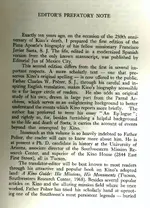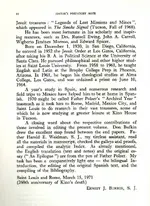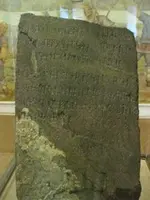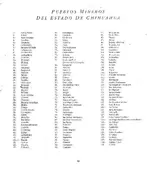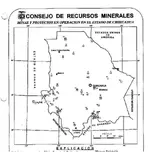cactusjumper said:
Paul,
It was interesting to read, but newspapers of that era provided a steady diet of that kind of story.
I have quoted Di Peso a number of times here, but he provides a great source for the early history of Tumacacori and the Pima Indians. You can search "rare books", if you would like your own copy, or try to find it in some local libraries. It's a bit pricey to purchase, but great to have in your collection. Leather bound is around $300, but I have seen paper backs for under $150. To say it's worth the money is, IMHO, an understatement.
In the opinion of many of his peers, he locates the original Tumacacori in the wrong place, but the body of his historical work is unmatched........in my opinion. That and $5 will get you an average cup of coffee these days.
I will get back to you on this, next week.
Take care,
Joe
Hola amigos,
This is yet another long-winded post, so I have to beg your indulgence again. Thank you in advance, and my apologies for not being able to put this into just a few words.
Interesting, that our amigo Joe <Cactusjumper> quickly dismisses those old newspaper accounts as so much fiction, without offering any grounds for classifying them that way. It sounds very similar to, and likely is referring to the very same article posted earlier - it ran in a number of newspapers. Within the reports we find no magic crystals, ghosts or cursed mountains, so I fail to see what grounds support the contention that they must be fiction.
There have been reports of 'secret' and/or illicit Jesuit mining operations about as early as there have been Jesuits active in the New World, which was even reported to the monarchies of Europe as a part and parcel of the accusations of Jesuit hi-jinx in the colonies. If we were to accumulate all of the reports of Jesuit mines in a single volume, it would amount to quite a large volume. This represents a rather long history of "fiction" - which by its very age in years, suggests that it is not fiction at all. Were it all truly fictional, by rights this age-old story of Jesuit mines ought to have dried up and blown away, like the reports of Unicorns that passed around civilization prior to the 'Age of Discovery' with the animals always existing in the far-off distant and un-explored lands. Yet there are Unicorns, even today - they are the single-horned Asian rhinos, as pointed out by Megasthenes and Marco Polo; so even those silly fairy tales of animals something like a horse, with a horn on its head, that was enemy to Elephants, was just a garbled transmission of real animals. I would say that our centuries-old traditions of Jesuit mines are not so different from the tales of Unicorns - that the "legends" are due to actual mining activities, operated illicitly in most cases (with the singular exception of Matape-Tecoripa) and deliberately hidden by the Jesuits due to troubles with Indians, impending expulsions, and the chances of having those mines taken away from them by the civil authorities. As for the Jesuits having "treasures" even father Och used that term, " The cathedral church possesses an exceedingly rich treasure in its gold and silver church appointments." Solid silver and gold, fall into the very category of what treasure hunters seek.
Joe I am not enthusiastic about attacking scholars or the work of scholars, but your repeated references to Charles Di Peso and his proposed location of San Cayetano de Tumacacori as well as his version of the history of Pimeria sort of forces me to do this. You mentioned that Di Peso's own peers pretty well dismiss his site for Tumacacori, on several grounds; one of the most important being that dating tests showed his site, now known as Paloparado, is from an earlier time period. An OSL test came up with a date of 900 AD, and 890 to 1250 AD. There are also human burials in the residential areas, which argues against Paloparado being the original Tumacacori.
Di Peso turned his attention to the controversial Acambaro figurines, (which included anachronistic dinosaur-like figures) and claimed to have minutely examined the entire collection (at the time over 32,000 figures) within not more than four hours spent at the home of Waldemar Jurlsrud whom had the collection at the time. That means he was minutely examining some 133 pieces per minute, over four hours. Does that sound like a careful examination, or a rather sloppy bit of research?
Di Peso may well be a great historian and excellent reference, but his work may not be quite so meticulous or un-biased as it could be.
Now I am certainly
no scholar, just a simple prospector/treasure hunter, and find it a little bit funny when some of us go to the extremes of contacting various scholars for the purpose of settling an internet forum debate. It is helpful to be sure, but considering that not all of us have a circle of friends that includes ranks of published historians, museum curators etc it seems a bit unfair. You can certainly find plenty of historians whom will agree that there never were any Jesuit mines or treasures, however I respectfully disagree. In researching anything historical in nature, the oldest sources are most often the most accurate. The oldest sources surrounding the Jesuits, have repeated reports of illicit Jesuit mining activities and of amassing great wealth; the fact that the Church was found to own over half of the country of Mexico on the Jesuit expulsion, that the Jesuits had large herds of livestock, and had been involved in just about every type of commercial and agricultural venture <
an impressive amount of capital, especially considering that many of the missions failed to even turn a profit> certainly doesn't help dismiss the mining accusations; especially when we have examples where the Jesuits were mining as admitted by father Polzer, the example at Matape found by Mr West, the rude (and brief) placer mining of copper by father Och, the record in Cananea, Pozos, etc. Were this a criminal case, and the defendant denied all criminal activity but we find actual records of SOME, along with a plethora of other reports, would we continue to maintain that criminal to be innocent, regardless of everything?
Gollum pointed out that the Jesuits were ordered to keep all communications about "secret" things, secret, or in code. Why should anyone expect then, to find incriminating records available to the public? Yet even so, such records of Jesuit mining activities are mentioned repeatedly by early treasure hunters. To the detriment of history, those early treasure hunters had no qualms about just taking any documents they discovered that might help them in their quest. For example;
La Cumbre District
The District of La Cumbre de San Manuel commonly referred to locally as La Cumbre is situated at the Southwest end of the San Juan valley in the municipal section of San Juan Nepomuceno. The mines in this district have an interesting history having been operated by the Jesuit fathers. There is a tradition in the district that when the Jesuits abandoned the mines they sealed up a number of the workings which have never been entered since. This is not at all improbable inasmuch as the Jesuits expected to return to the country at some future time. It is stated that the records of the mining operations of the Jesuits are still kept in Alamos Sonora and I understand these records are now being searched and those parts of interest are being translated.
<The proceedings of the Colorado Scientific Society, 1905, 1906, 1907 Volume 8 By Colorado Scientific Society, Denver 1908; Notes on Mining Conditions in and a Section Across the Sierra Madre Mountains in Mexico by AW Warwick pp153>
This is just one example, that parallels the newspaper account in which the Jesuit padre found records of the old mines. These records we may as well admit, have vanished. The fact that such records cannot be turned up on the click of a mouse today, does not prove the records did not exist formerly, and some examples may still exist in archives which we do not have ready access to. (I have my fingers crossed on the Portuguese national archives, at present it is not even indexed.) The fact that we have a number of articles that refer to actual records of Jesuit mines, certainly points to the fact that there WERE such records.
I had tossed out a name of a Jesuit of some standing, with the surname of Molina; half expecting someone to raise an issue with it. Luis de Molina penned a doctrinal defense of the institution of slavery, basing his arguments on scripture, moral and civil law. To be sure there were a handful of Jesuits who stood against slavery, but in two cases the Jesuits were quickly recalled from the New World and even those who did issue statements against slavery, were in some cases themselves owners of slaves and operators of slave-plantations. The African slaves were brought in to replace the Amerindian workers (un-paid, forced labor, by people whom were not free to leave the missions) so really Infosponge had hit the nail on the head by pointing out there is little difference between Amerindian forced labor and African slave labor. We could carry the comparison even further; slaves from Africa were bought and sold as chattel (property); Amerindians were likewise traded, willed etc as "encomendio" - certain amounts of forced labor, per village, or per tribe, for so many months per year. The mission Amerindians were not quite on the same basis as African slaves, but not far different either.
Good luck and good hunting amigos, I hope you find the treasures that you seek.

Oroblanco







